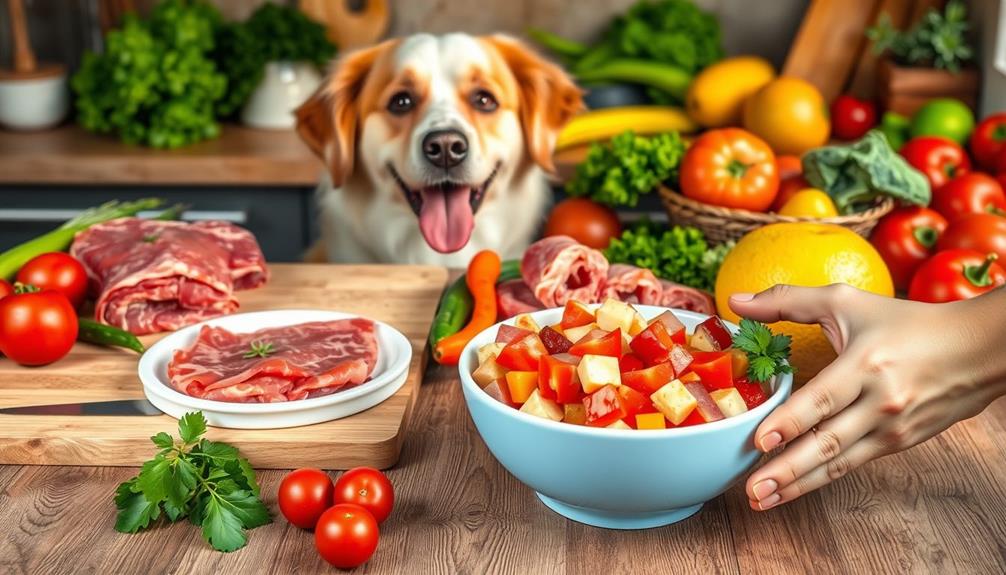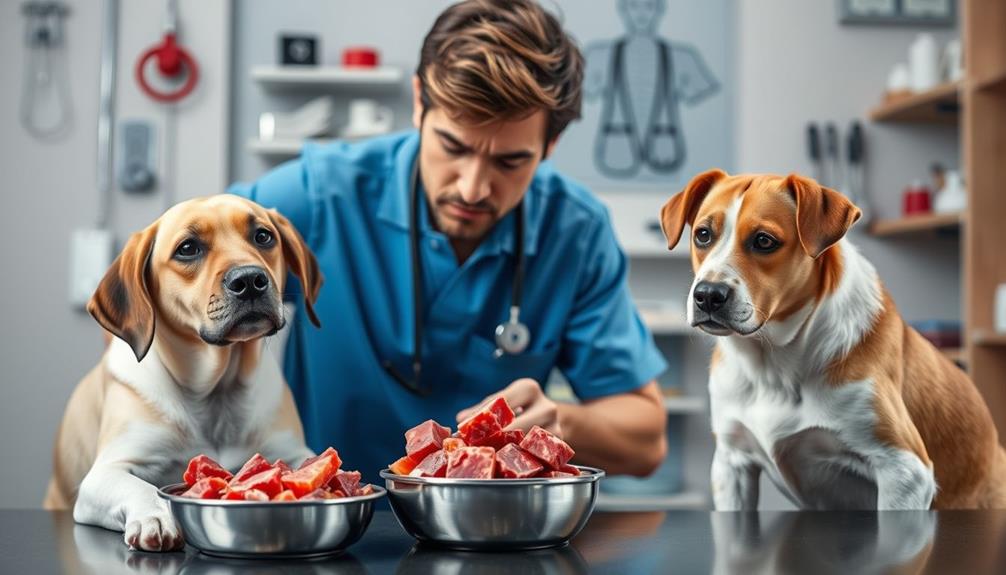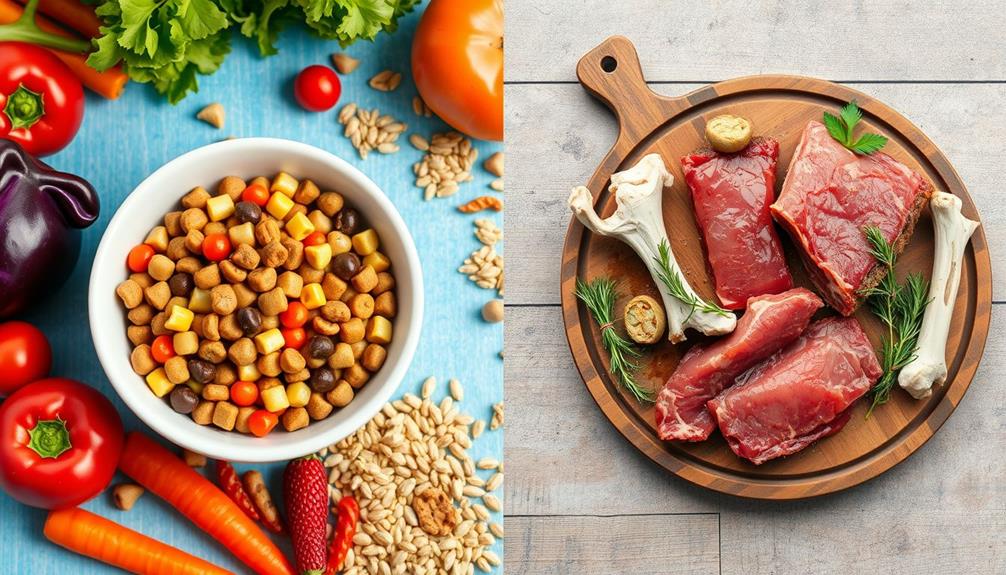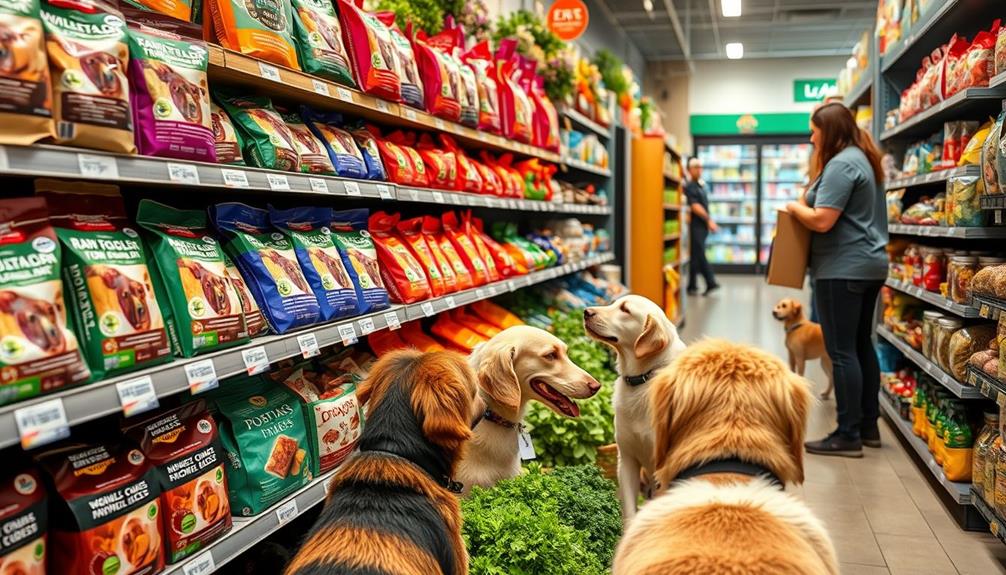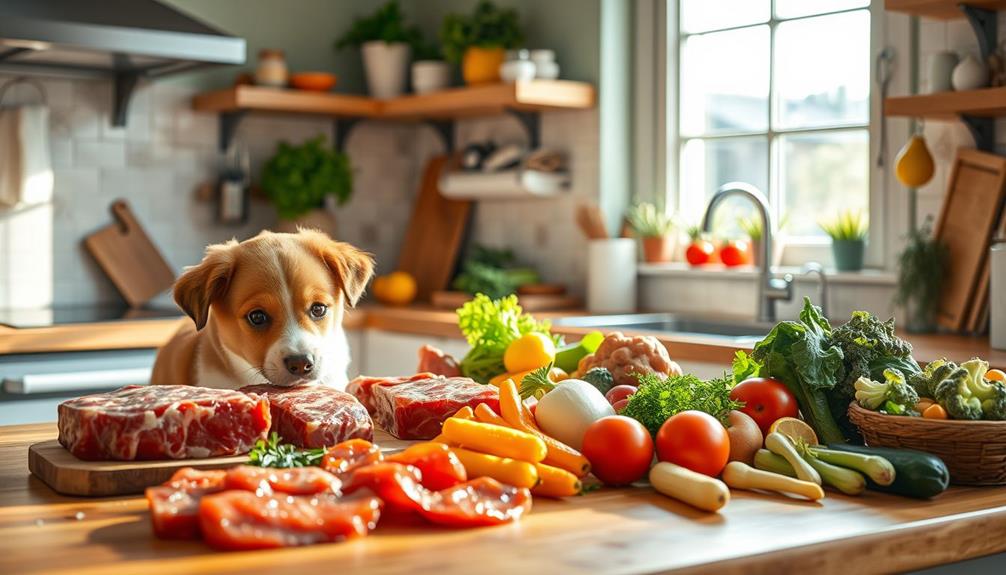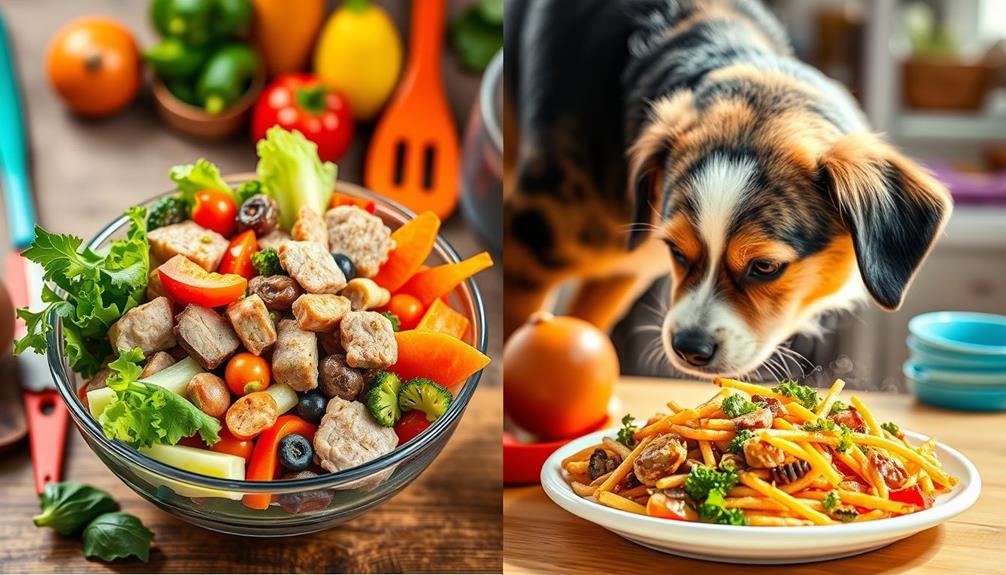To wean your dog onto raw food, start with a gradual change over 7 to 10 days. Mix 75% kibble with 25% raw food initially, slowly adjusting the ratio. Consider enhancing the raw meals with flavor boosters like low-sodium bone broth or lightly seared meat to make it more appealing. Monitor your dog's stool consistency and overall health, as detox symptoms like loose stools or vomiting may occur. Confirm you're using high-quality, human-grade ingredients for a balanced diet. As you adjust your dog's meals, you'll discover more beneficial tips and strategies to make the change easier. Consider consulting with a veterinarian or a pet nutritionist to ensure that your dog’s raw food diet meets their specific nutritional needs. Additionally, research different feeding methods and recipes for raw food for dogs to provide variety and essential nutrients. With patience and consistency, your pup can thrive on a balanced and carefully planned raw food diet.
Key Takeaways
- Gradually transition your dog to raw food over 7 to 10 days, starting with 75% kibble and 25% raw food.
- Enhance raw meals with flavor boosters like canned sardines or low-sodium bone broth to increase appeal.
- Monitor stool consistency and overall health, making adjustments as necessary during the transition.
- Be aware of detox symptoms such as vomiting or loose stools; consult a vet if severe symptoms arise.
- Choose high-quality, human-grade raw food brands that offer balanced diets tailored to your dog's specific needs.
Transitioning Approaches and Methods
When changing your dog to a raw food diet, you'll find that there are two main approaches: a rapid switch or a gradual one. The rapid switch involves an immediate change to a raw food diet, but this can lead to potential digestive issues. If your dog has a sensitive stomach or existing health issues, you might want to take into account a gradual change instead.
Understanding the importance of monitoring your dog's health during this time is vital, as it can help identify any adverse reactions or adjustments needed for their specific needs, similar to financial considerations for elder care.
A gradual change typically spans 7 to 10 days, starting with a mix of 75% kibble and 25% raw food. You'll gradually increase the raw portion while decreasing kibble until you reach 100% raw.
There are several methods for this gradual change. The Treat First Switch introduces raw food as a treat initially, making it easier for your dog to adapt. The Separate Meals Switch serves old and new foods separately, easing the process further. For especially sensitive dogs, the Cook Before Raw Switch allows time for their stomach flora to adjust before fully switching to raw.
Throughout the change, it's important to monitor stool consistency and overall health. Adjustments may be necessary based on your dog's reactions to the new raw food diet.
Enhancing Raw Meal Appeal
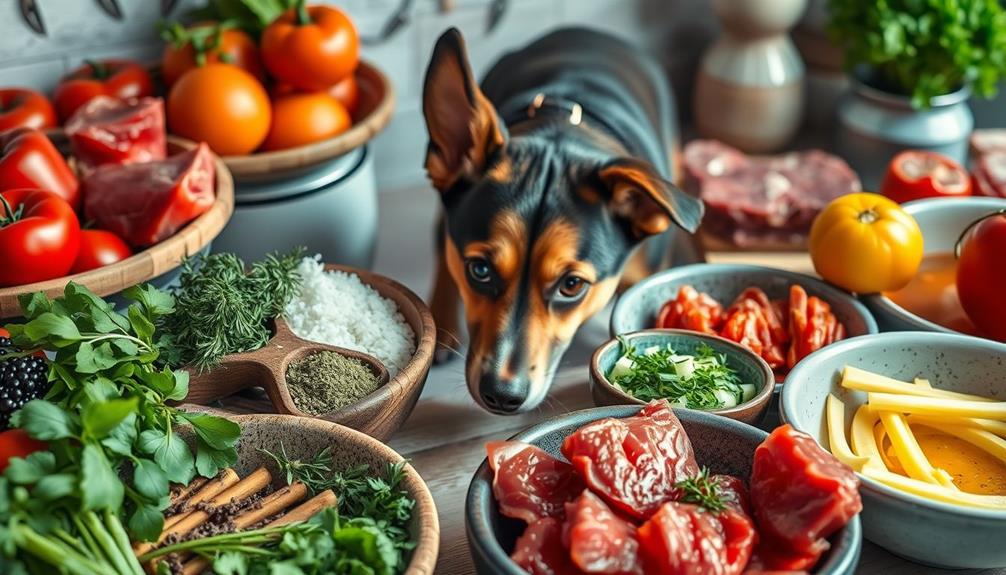
Finding ways to make raw meals more appealing can greatly ease your dog's adjustment to this new diet. One effective method for enhancing raw meals is to add flavor boosters that entice your pup. Consider mixing in canned sardines, low-sodium bone broth, or goat's milk to cater to their taste preferences. These additions not only enhance flavor but also provide additional nutrients.
Additionally, incorporating safe vegetables can contribute to a well-rounded diet, much like the proper diet for hamsters, guaranteeing your dog receives essential vitamins and minerals.
Another technique is to lightly sear the meat before serving. This releases enticing aromas that can make the raw food more appealing. As your dog becomes accustomed to the raw diet, gradually reduce the searing to help them adapt smoothly.
Don't forget to experiment with different fruits and vegetables as well. These can add variety and excitement to their meals, keeping their interest in raw food high.
Always monitor your dog's reactions to these enhancements, making adjustments as needed to guarantee a balanced and enjoyable feeding experience. By actively engaging in this process, you can create a raw meal routine that your dog loves and looks forward to.
Managing Expected Changes
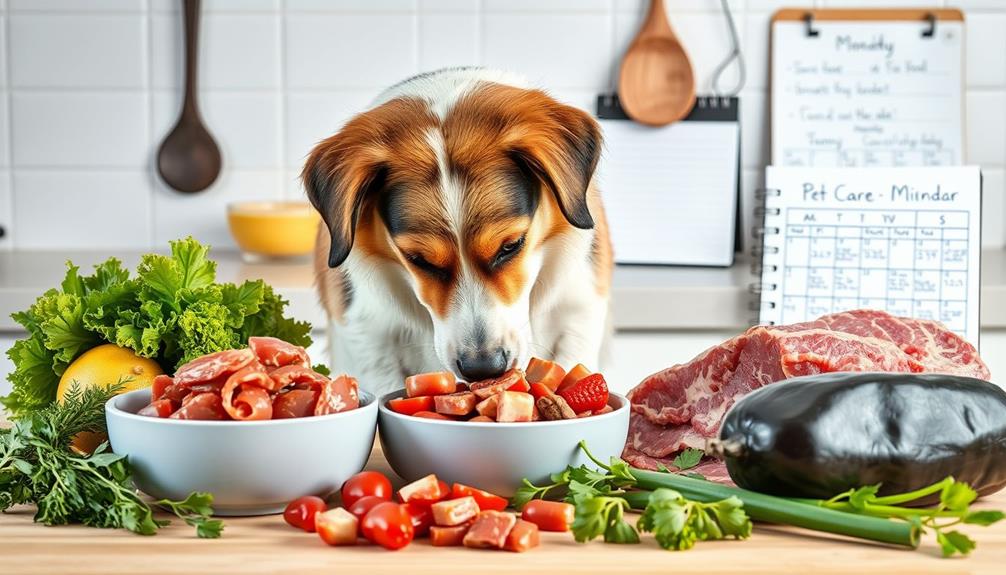
Shifting your dog to a raw food diet can come with some expected changes, and managing these adjustments is essential for their well-being. During the changeover, you might notice detox symptoms like vomiting, loose stools, or bad breath as your dog's digestive system adapts.
It's important to select appropriate foods that can aid in this changeover, similar to how understanding cold medications overview helps in managing symptoms. While loose stools can be concerning, incorporating plain canned pumpkin into their meals can help firm things up. If you see mucus-covered stools, don't panic; this is often a sign of detox and usually isn't serious.
As your dog becomes accustomed to raw dog food, expect them to produce smaller and firmer stools, thanks to improved digestion and less waste.
It's essential to keep a close eye on your dog's hydration needs during this time, as raw food has a higher moisture content. Always guarantee they've access to fresh water.
Monitoring for other detox symptoms, like runny eyes or dry skin, is important. If your dog experiences severe reactions, don't hesitate to seek a vet consultation to make sure their health isn't compromised.
Benefits of a Raw Diet
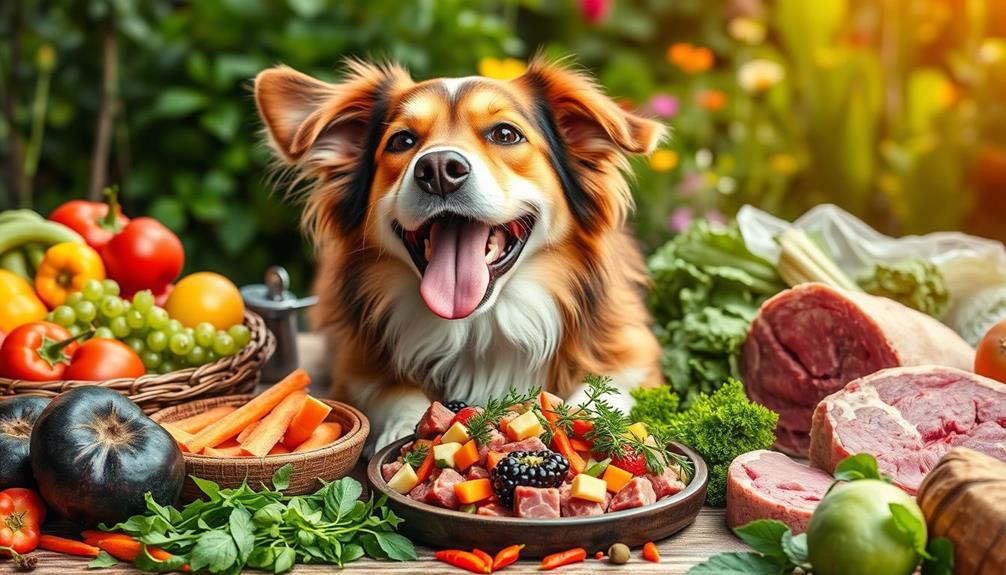
A raw diet offers numerous benefits that can greatly enhance your dog's health and well-being. One of the primary advantages is the improvement in your dog's immune system, thanks to the nutrient density of raw foods. These foods provide essential nutrients that support ideal digestion and overall vitality, much like how easy composting can improve soil health for plants.
With a raw diet, you may notice an improved coat condition, resulting in a shinier and healthier appearance for your furry friend.
Additionally, raw feeding can markedly boost your dog's dental health. The natural chewing of raw meats helps reduce plaque and tartar buildup, promoting cleaner teeth and fresher breath. Many pet owners also report increased energy levels in their dogs after making the switch. This newfound vitality can be attributed to the high-quality nutrients found in raw foods.
Another notable benefit is the potential to alleviate chronic health issues, such as allergies and obesity. By eliminating fillers and artificial ingredients commonly found in commercial pet foods, a raw diet can lead to a healthier, happier dog.
Selecting Quality Raw Food
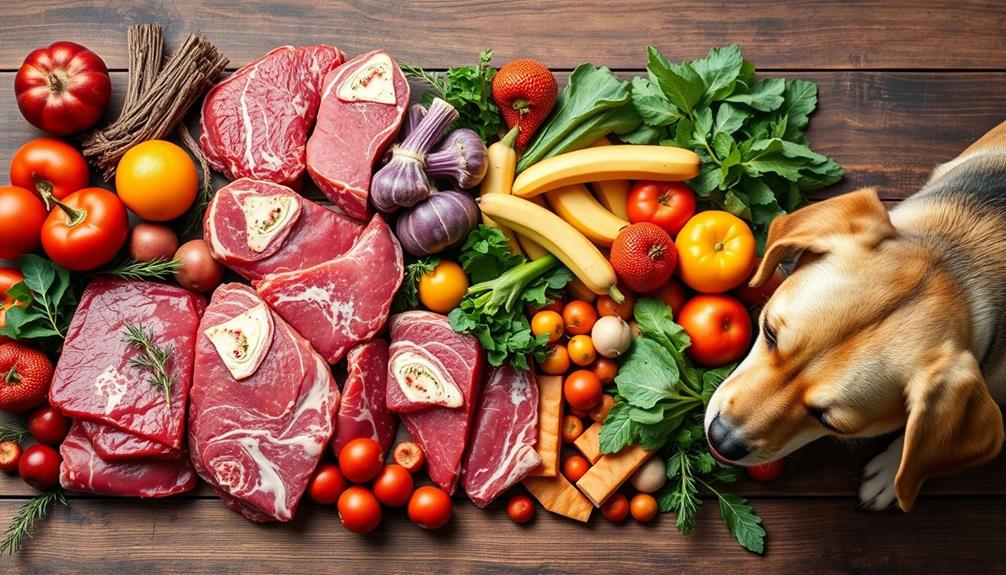
Choosing quality raw food for your dog is fundamental for guaranteeing their health and happiness. Start by prioritizing brands that use high-quality, human-grade ingredients sourced from reputable suppliers. This guarantees the safety and nutritional value of the food you're providing.
Aim for a raw food diet that's balanced and complete, incorporating various protein sources, organ meats, and the right ratios of fruits and vegetables to meet your dog's dietary needs. A diet rich in antioxidants, like those found in certain fruits, can also support overall health and vigor, similar to the benefits of Cranberry Juice Consumption.
Transparency in ingredient sourcing and production methods is essential. Reputable companies often share detailed information about their sourcing practices and manufacturing processes, giving you confidence in what you're feeding your pup.
Consider your dog's specific nutritional needs based on their breed, age, and any health conditions they may have. Some raw diets can be tailored to help prevent common health issues linked to certain breeds.
Before making a final decision, review customer feedback and ratings. Consulting with veterinarians or pet nutritionists can also help you determine the best raw food options for your dog's unique requirements.
This thoughtful approach will guarantee your dog gets the nutrition they need to thrive.
Frequently Asked Questions
How Long Does It Take for a Dog to Get Used to Raw Food?
It usually takes your dog about 7 to 10 days to adjust to raw food, but some may need longer. Monitor their stool consistency and be patient as they adapt to the new diet.
How to Wean Your Dog off Raw Food?
"Rome wasn't built in a day." To wean your dog off raw food, gradually mix in quality kibble, starting with a small percentage. Monitor their response, ensuring a smooth changeover and maintaining a consistent feeding routine.
How Should I Introduce Raw Food to My Dog?
To introduce raw food to your dog, start gradually. Mix 75% kibble with 25% raw for a week. Monitor your dog's health and adjust portions as needed, ensuring a smooth and healthy changeover. After the first week, you can increase the raw food portion to 50% while reducing the kibble to 50%. Again, monitor your dog’s health and adjust the portions as necessary. After another week, you can switch to feeding 100% raw dog food and monitor your dog’s health closely to ensure they are adjusting well to the new diet. Remember, switching to raw dog food should be done gradually to prevent any digestive upset.
Do Dogs Detox When Switching to Raw?
Switching your dog's diet can feel like a rollercoaster ride. Yes, dogs detox when changing to raw food, often showing symptoms like loose stools and bad breath. These usually pass in 10-14 days, so stay patient!
Conclusion
As you commence on this raw food journey for your dog, remember that patience is key. You might just witness their transformation into a vibrant, energetic companion, but be prepared for some surprises along the way. Will they take to it easily, or will you face unexpected challenges? The rewards can be incredible, but it's up to you to navigate this exciting path. So, are you ready to uncover the benefits that await both you and your furry friend?

